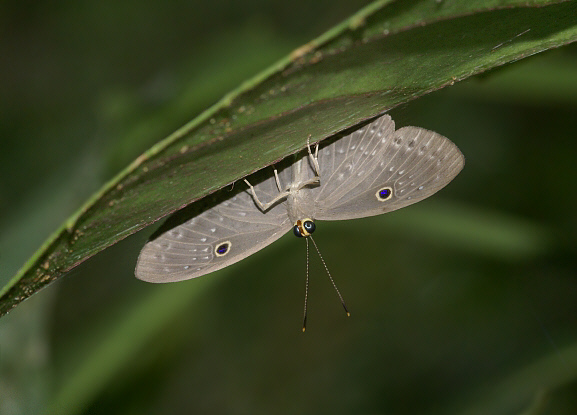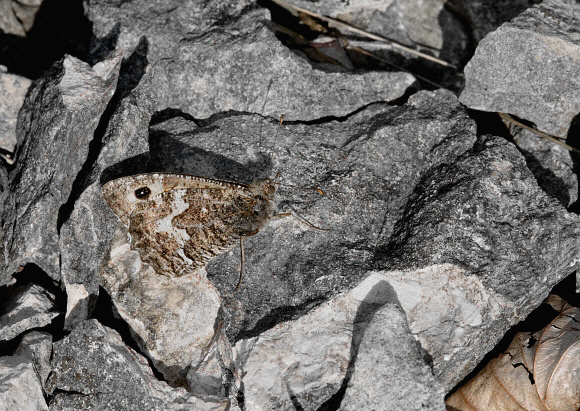Hearing organs
Some butterflies, including the Hamadryas Crackers and Heliconius Longwings, can detect sound using an “ear” near the base of the underside of their wings. The ear, visible only under a powerful microscope, takes the form of a funnel-shaped sac covered with a very thin membrane. This membrane vibrates in response to high-frequency sound, stimulating nerve cells called scolopidia, which send messages to the butterfly’s brain.
Hamadryas butterflies use their ears to detect crackling noises made by territorial males, produced by twanging two tiny prongs on the tip of the abdomen against bristles on the valvae.
Males habitually bask on tree trunks, waiting to intercept passing females. It has been speculated that the sound might deter competing males from occupying the same territory, but a single tree trunk will often host 3-4 males perching in close proximity. It seems more likely that the sounds act as a trigger to initiate responses from females during courtship.
Kathleen Lucas of the University of Bristol used a laser beam to scan the membrane of the eardrum of Morpho peleides (= helenor). She found that lower frequencies between 1000 – 5000 Hz caused vibrations to focus on a spot on the outer membrane, but frequencies above 5000 Hz caused the entire membrane to vibrate, including the “fried egg” dome structure arrowed in the photo. Moth ears respond equally to all frequencies, but Morpho butterflies seem able to differentiate between low and high-pitched sounds. Lucas speculated that this could help the butterflies figure out if birds are about to attack. If, for example, they could tell apart the sounds of flapping bird wings and those of bird song, it might trigger different escape responses by the butterfly.
Some scientists believe that when butterflies first evolved, they were nocturnal, and their ears originally served to detect and avoid predatory bats. Bats emit acoustic pulses when flying at night and use their highly sensitive ears to detect the echo reflected back by solid objects. This way, they avoid hitting unseen obstacles and are able to locate moving prey in the dark.
Noctuid moths (and certain other groups) are able to hear a bat’s acoustic pulses. The frequency and volume enable the moth to detect how far away the bat is. Furthermore, the relative positions of the moth’s hearing organs enable it to determine the direction of approach. The moth initially reacts by steering away from the bat, but if it gets within striking distance, the moth instantly dive-bombs to avoid being eaten.
Nerve cells similar to those in the “ears” are also found in enlarged veins at the base of the forewings of many butterflies. These are particularly well-developed in Satyrines such as Oressinoma, Maniola, Pararge, and Hipparchia, all of which react instantly to the sound made as dry leaves are crunched underfoot or to the noise made by the shutter of a camera.
Flight
Insect flight evolved at least 90 million years ago, long before it appeared in birds or bats, so its original function must have been for something other than predator avoidance. The most likely explanation is that it evolved to enable insects to reach food sources by the most direct and rapid route. What is not currently understood is the method by which the evolution took place.
Some have suggested that wings evolved from nodes on the thorax. Another possibility is that they may have originally appeared as short flexible thoracic hairs, akin to cat whiskers, which enabled the insects to find their way through burrows. Once insects began to climb plants, they may have evolved further as a way of cushioning the landing of falling insects and ultimately as a means of easier dispersal, mate location, and food location.
Skippers tend to have a buzzing moth-like flight, and other small butterflies such as Lycaenids and Riodinids need to beat their wings rapidly to propel themselves through the air. Larger species such as Nymphalids, Pierids, and Papilionids fly by a combination of flapping and gliding. When gliding, the wings are held so as to create a concave under-surface, producing a parachute effect which slows the rate of descent. These larger species also make use of thermals to gain or maintain height when gliding above the forest canopy or when migrating.
Males of many species adopt a “perch and wait” mate locating strategy and need to be able to take flight rapidly to intercept potential mates. Examples include Skippers (Hesperiinae), Metalmarks (Riodinidae), and Graylings (Satyrinae). These species often tend to have triangular forewings with a particularly thick and straight costa. The springy qualities of the costa, in combination with their powerful flight muscles, enable them to accelerate rapidly at takeoff.
Other species, such as Whites (Pierinae), Swallowtails (Papilionidae), Blues (Lycaenidae), and Morphos (Morphini), adopt a “patrolling” mate location strategy. Thus they have no need for such rapid acceleration. They tend therefore to have rounder and less robust wings, which are larger in relation to their thinner and less muscular bodies. Consequently, their flight is much lazier.

In the neotropics, Eurybia butterflies ( Riodinidae ) habitually spend long periods resting upside down and with wings spread open, beneath the leaves of low growing vegetation. Flight analysis has shown that by doing so they are able to take off much more rapidly than they could if they rested the “right” way up. From their hiding place they keep a watchful eye on passing insects.
Periodically they dash out to intercept and investigate other butterflies, but instantly return to settle under a nearby leaf. The speed of flight is remarkable, and the degree of agility apparent when they fly into the vegetation, flip upside-down and settle under another leaf is quite amazing to behold.
Thermo-regulation
Butterflies are cold-blooded. If they are too cold they cannot fly. If they get too hot they become dehydrated and die. They have no internal means of regulating their body temperature, so they need to use behavioural strategies instead.
In cool conditions butterflies need to raise their body temperatures before they are able to fly. To do so they use a technique known as dorsal basking, whereby they use the upper surface of their wings as solar panels to absorb heat and give them energy. Often they settle to bask on pale, heat-reflecting substrates such as stones, tree-trunks or patches of bare ground.
Heat is reflected back from the substrate and absorbed by the dark undersides of the wings, speeding up the warm-up process. Males in particular use this method, to ensure that they always have sufficient energy available to enable them to instantly fly up to intercept passing females.
Some butterflies, such as Clouded Yellows, Graylings & Green Hairstreaks, always keep their wings closed when at rest, and adopt another technique known as lateral basking. In cool conditions they bask by tilting their wings over to one side, so as to present the maximum area of wing surface to the sun. Conversely, when they get too hot, they tilt in the opposite direction so that their wing surfaces are parallel to the sun’s rays, and present the minimum surface area to the sun.

The Whites, Blues and Coppers have wing surfaces which reflect, rather than absorb solar energy. Consequently they bask with their wings half open, so that the heat produced by sunlight falling on the dark thorax is contained within the “cage” of the half-open wings, rather than being dispersed on the breeze. This behaviour is called reflectance basking.
Another method used to raise body temperatures is “shivering”. Many Nymphalid species, including Peacocks, Small Tortoiseshells & Red Admirals prepare themselves for flight by rapidly shivering the wings ( which are held closed during this process ). Even on the coolest day, a minute or two of this activity generates enough friction to heat up the thoracic muscles enough to enable them to fly short distances. Nocturnal moths often adopt the same technique.
Butterflies can only operate within a limited temperature range, so on hot days they need to find ways of keeping cool. Forest-dwelling species simply hide beneath leaves, while species that inhabit open areas often fly into bushes to seek shade, or enter rabbit burrows.
